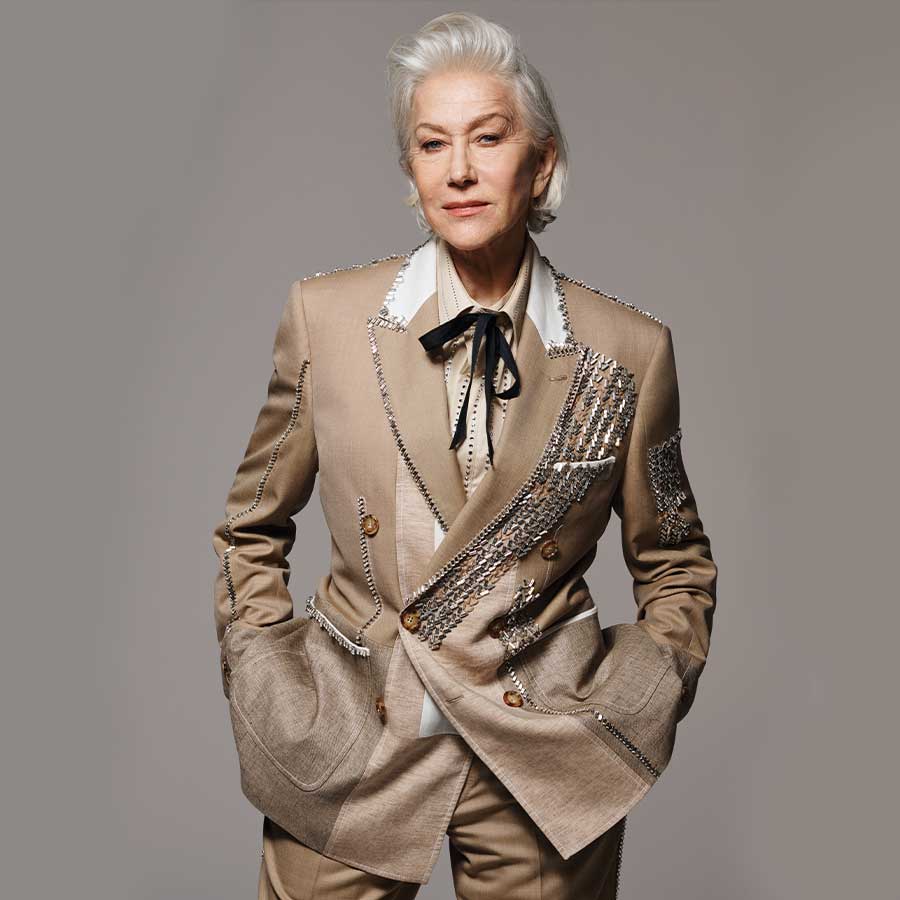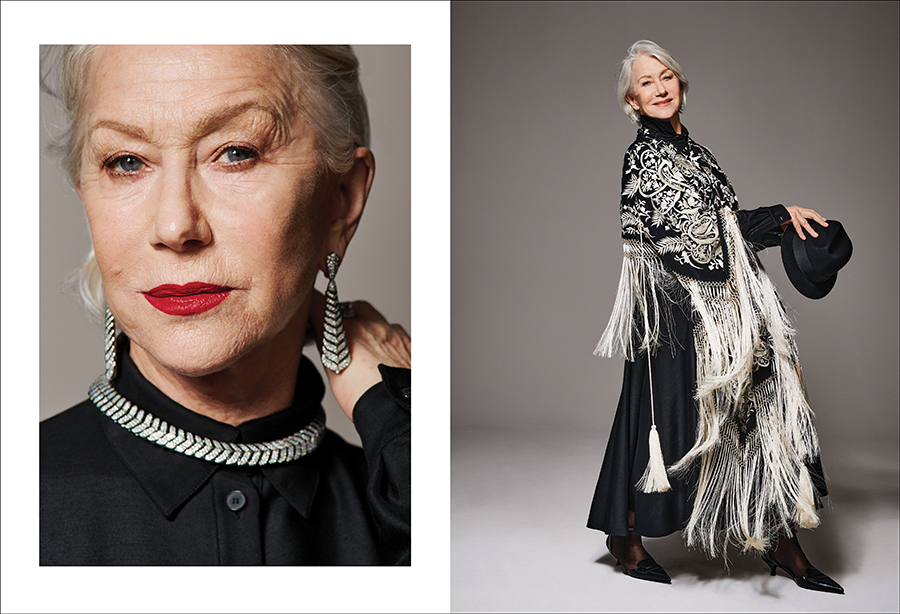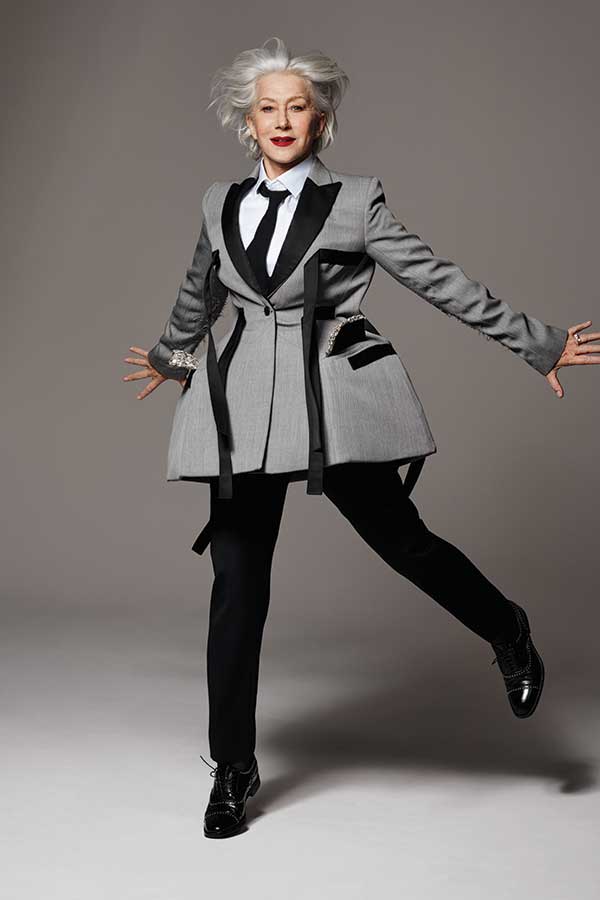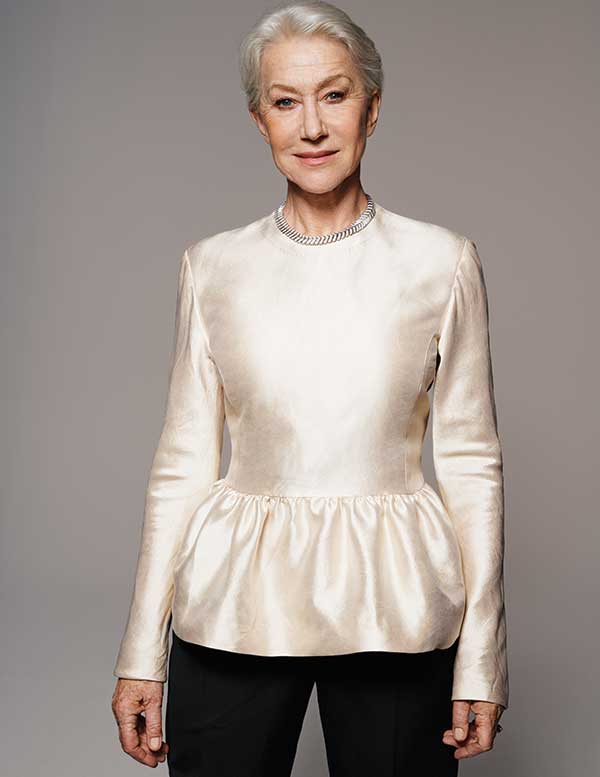Dame Helen Mirren on Her Early Career and Why She Approaches Roles “the Way a Painter Paints a Portrait”

Dame Helen Mirren, who's played both Queen Elizabeth I and II, is set to play another powerful woman as she steps into the role of Israeli Prime Minister Golda Meir in a new biopic landing later this year. Photo: Liz Collins/Trunk Archive
If Helen Mirren were to steal a painting from the National Gallery in London, it would be a Wassily Kandinsky. “I love Kandinsky,” she says of the Russian painter, known as the father of 20th-century abstraction, although if you strolled through a gallery of his work, you might never know it’s all from the same man’s brush. Among his oeuvre, you’ll find art that incorporates impressionism, expressionism, surrealism, Art Nouveau and Bauhaus.
Similarly, the many, many facets of Dame Helen were showcased in the spliced compilation reel shown at the 2022 Screen Actors Guild (SAG) Awards before she collected her Lifetime Achievement Award in February: Shakespearean thespian in Antony and Cleopatra and Hamlet; drunk and gruff Detective Jane Tennison in Prime Suspect; regal as Queen Elizabeth I and II; a fully naked Caesonia in the 1979 Penthouse-funded erotic film Caligula; campy criminal mastermind Magdalene Shaw in the even campier Fast & Furious franchise, movies seven through nine; and, in The Duke, her new film that opens this spring, a frumpy and sour-faced wife who discovers her husband is hiding a stolen painting by Mirren’s second choice of artist to loot, Francisco de Goya.
The Duke is based on the true story about a disabled British pensioner, Kempton Bunton, who is incensed to learn his government paid millions to keep de Goya’s portrait of the Duke of Wellington, a Tory prime minister and war hero, from being sold to an American collector. Nineteen days after its display at the National Gallery in 1961, the masterpiece disappeared. Was it the cunning work of an heist expert? Or the accidental misadventures of a good-hearted, working-class retiree on a crusade for free TV licences for seniors?
“You couldn’t sell this story if it were a work of fiction,” says actor Jim Broadbent, who plays Bunton in The Duke. Portions of Bunton’s sensational trial — no spoilers! — were used verbatim, delivered in perfect Newcastle accents. Since Mirren’s ever faithful to her real-life characters, she required a serious make-under for her turn as Bunton’s wife, Dorothy. “When I first saw her in her wig and costume, it made me laugh,” he admits during a Zoom press conference from London, where they’re promoting The Duke. “She’s always been a glorious and glamorous actress. You see past the cardigan and her inner beauty comes shining through.”

Okay, okay, we get it: At 76, Mirren is beautiful, inside and out. She’s aging like a badass, no eternal youth serum required, and she looks better in a red swimsuit than all of us. So I’m not sure what — or who — to expect when Mirren appears on screen, but, obviously, she looks way better than I do on today’s video call, where I’m regretting wearing my sartorial choice of glasses and ponytail (in my defence, it’s 8 a.m. in Toronto, and the glasses are Chloé, a small saving grace). Mirren, meanwhile, may as well have walked directly off a red carpet in a parakeet-green pleated silk dress from ME+EM with a Jane Taylor headband that sparkles like an actual crown. I’m certain she’s long sick of questions of the “how do you possibly look so good?” variety, though truthfully it’s the first thing that pops to mind.

That said, it could be worse, and not too long ago, it really was. In 1975, during Mirren’s very first talk show appearance, U.K. journalist Michael Parkinson introduced Mirren as the Royal Shakespeare Company’s “sex queen,” known for “projecting sluttish eroticism.” Parkinson then asked if her “equipment” hinders her pursuits as a “serious actress” (he indeed uses air quotes). “You mean my fingers?” she asks, though she’d surely rather have shown him the middle one. Mirren kept her impressive composure for 36 long years, when, in a 2011 interview with The Telegraph, she publicly called him a “sexist old fart.”
Vowing to be nothing like Parkinson, I toss the Dame a curveball in a follow-up email: “What question does nobody ever ask that you really wish they would?” In an audio file she sent in reply, Mirren mulls a minute and then answers, kind of. “My favourite interview would be one with no questions at all, quite honestly,” she says. “One where you just sit down and have a conversation about gardening or sewing. I love sewing.”
Sewing? It’s suddenly very clear to me that I don’t actually know anything about Helen Mirren. This feels deliberate. “It’s a mistake to confuse the actress with the person on the red carpet,” she cautions, with no mention at all of the real person behind the actress. I think of how much I know, with nary a Google search, about the actresses of my generation, like Jennifer Lawrence (new baby!), Lena Dunham (endometriosis) and Drew Barrymore (thrice divorced and too nervous to date). Each of them is a friendly open book, bless their hearts, but they are forever fated to play slightly different versions of themselves.
For details on Mirren, you have to dig into her 2008 biography, In the Frame. Descended from Russian aristocrats exiled to England during the Bolshevik Revolution, the formerly rich Mironov family started over in London’s East End and soon Anglicized their last name to Mirren. Ilyena Vasilievna Mironov entered this world with top honours — the middle child of three was born in just 20 minutes, the fastest birth on record at Queen Charlotte’s and Chelsea Hospital. When she turned three, the family moved to the more affordable Essex County, although they still couldn’t afford a car, central heating, a washing machine or a refrigerator. Needless to say, there was no TV, so the family visited art galleries for a free dose of art and culture.

At her stuffy Catholic school, young Mirren excelled at drama, even though she didn’t particularly like it at first and begged her mother for permission to quit. An impressed English teacher suggested she apply for the National Youth Theatre, where she was so convinced of inevitable rejection that she auditioned in secret. At 17, Mirren made the cut. Her portrayal of Cleopatra earned her an agent, and though she finished teacher’s college so she wouldn’t have to repay a grant, it was clear Mirren would never be a schoolteacher.
Instead, she joined the Royal Shakespeare Company and began carving a niche as Shakespearean thespian in — and this is just a short sampling here — Hamlet, All’s Well That Ends Well, Macbeth, Richard III, Henry VI, and Much Ado About Nothing. On screen, she has appeared in As You Like It, The Tempest, A Midsummer Night’s Dream (twice) and Hamlet (again). Were Mirren any other actress, she probably would have settled into the theatre scene and safely stayed put.
But Mirren, like Kandinsky, does not believe in artistic monogamy. So when she was asked to appear in her first film, she couldn’t resist a substantial pay raise and trip to Australia to film Age of Consent, which paired her, at 24, with 60-year-old James Mason, who’d also starred in Kubrick’s Lolita. (Gross fact: Lest she seem too mature, producers billed her as 22.) Her 1969 film debut featured so much revealing nudity that it required editing for a North American audience, and projectionists stole the cut frames to take home as keepsakes.
Age of Consent solidified Mirren’s sexpot status for decades to come, but if she regrets her more provocative choices, she’s not saying so. “The reality is we all make mistakes in life and you live with it,” she tells me in the email. “There are, of course, roles I’ve been asked to do that I didn’t and regret bitterly.” Which ones, out of respect for her fellow actors who got the parts, she’s not saying.
In 1984, Mirren crossed the Atlantic to Hollywood for the sequel to Kubrick’s 2001: A Space Odyssey, where she played a Soviet astronaut on a mission to Jupiter in the hilariously-titled-in-retrospect 2010: The Year We Make Contact. Although Captain Tanya Kirbuk is not one of Mirren’s more memorable roles, it was significant because it caught the eye of her future husband, American director Taylor Hackford. Theirs was not a meet-cute: Mirren was furious that he was 20 minutes late to a meeting and loudly said so. More importantly, Hackford was already married, with two children from two marriages, and Mirren feared matrimony so much she suffered recurring nightmares about weddings.
She returned to London to escape their attraction, but six months later, Hackford separated from his wife and followed her there. “My fate was sealed,” Mirren wrote in her biography. She conquered her fears to wed Hackford in 1997, and the couple is going strong to this day. “We’ve been together 40-odd years, a ridiculous amount of time,” Mirren tells me. Still, they manage to amuse each other, if only for the always-entertaining cultural divide. “We’re constantly finding words that we don’t understand in each other’s language — American and English — and we can still sometimes be surprised by words that we’ve never heard coming out of each other’s mouths.” Mirren only recently discovered Hackford likes Marmite, she tells me, which is a nice coincidence, since she also likes the savoury spread.
Fittingly, the couple splits their time between London and Lake Tahoe, where Mirren recently shooed a black bear cub off the porch (“Go on! Naughty bear!” she commands in the viral video, and the bear immediately complies).
They vacation at their restored, 16th-century farmhouse in Tiggiano, Italy. It’s here, surrounded by olive trees and a vineyard, where Mirren feels her best self. “I feel utterly comfortable there, amongst our neighbours in our local town,” she told the press group, asking us to kindly mention the little town she loves so much by name. Mirren was recently seen cleaning garbage off the side of the road.
If the above image is hard to conjure, it might be because the glamorous almost-EGOT winner — she only needs a pesky little Grammy — is almost synonymous with Queen Elizabeth I and II, who have never been spotted picking up litter. It’s a daunting task to play the most famous woman on the planet, since failure can feel inevitable. “I used to think it’s a no-win game playing living characters, because you’re never as good as the person is at being themselves,” she tells me. Whatever the role, from Her Majesty Queen Elizabeth to The Duke’s working-class Dorothy Bunton, Mirren has freed herself by thinking of her performance “the way a painter paints a portrait, where they put their understanding of that person into the painting. It becomes not just an impersonation, but an observation.”
She will soon transform again, this time into former Israeli Prime Minister Golda Meir, in the upcoming biopic Golda. The casting choice prompted criticism from actress Dame Maureen Lipman. “The Jewishness of the character is so integral,” she told the Jewish Chronicle. “I’m sure she will be marvellous, but it would never be allowed for Ben Kingsley to play Nelson Mandela.” The comment reignited a familiar debate about representation, with Jewish actors, playwrights and even rabbis weighing in with opinions from all sides and walks of life. Needless to say, there was no consensus, which is just fine by Mirren. Rather than shy away from the controversy, she told the Daily Mail the discussion was “utterly legitimate,” and welcomed new opinions, particularly from younger generations. “The job of the young is to stand up and say, ‘No, we’re not having that. It’s wrong,’” she says. “I love it when they do that. The desire for change is there and I’m full of admiration for them.”

Mirren is a very serious actress who doesn’t take herself too seriously — an irresistible combination and one that lends itself perfectly to the social media age, where Mirren gleefully pokes fun at herself at every opportunity. For a 2021 Zoom interview with Jimmy Fallon, she logged in from her bathtub. (“I’m running out of bubbles, though. That’s the problem.”) She’s got an ongoing flirtation with Ryan Reynolds (on one particularly amorous shot on Instagram, his wife Blake Lively joked, “Should I be concerned that my husband’s never looked at me this way?”) Even a candid snap by a stranger of Mirren riding the NYC subway in 2015, oversized tote held gracefully on her lap with gloved hands, went viral on Instagram. There, Mirren balances glamorous red carpet shots with #nomakeup selfies, which she posts with a purpose. “In return for this pic of me literally first thing in the morning, please donate to intensive care support at,” she wrote, with a link to a COVID fundraising site, alongside a sleepy 2020 selfie taken in bed.
Even on the SAG Awards stage, following a fawning introduction from Kate Winslet, Mirren accepted her Lifetime Achievement Award with characteristic humour and humility. “I suppose I’m still alive, so by that measure I’m eligible,” she cracked. In a custom floor-length Dolce & Gabbana gown, ballet pink with shimmering floral details at the shoulder and waist, she continued, slyly spelling out “S-A-G,” because, she noted, “I hate to say the word ‘sag’ at my age.” She dedicated her acceptance speech to “our tribe of rogues and vagabonds,” that is, her fellow actors, whom she thanked “for your wit, your humour, all the laughter and the giggles, your perception, your emotional generosity, your great intelligence, your incredible energy and your helpless dedication to our chosen profession.”
Right back at ya, Dame Helen. For your ability to be anything and anybody, for saying yes to Oscar-calibre roles and a Drop the Mic rap battle with James Corden with equal enthusiasm, for building a body of work that defies classification, for never, ever being boring. And hardly at all for looking fabulous while doing it.
A version this article appeared in the April/May 2022 issue with the headline ‘The Face That Launched a Thousand Pictures’, p. 34.
RELATED: